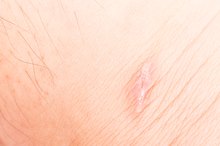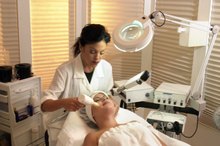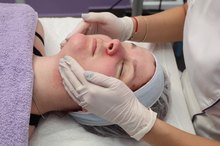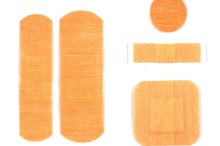How to Get Rid of Scars From Belly Piercings
Body piercings are a popular form of cosmetic expression. Unfortunately, if a piercing becomes infected, is inadvertently pulled out or otherwise traumatized, a scar can appear in the healed area. Scars don't usually match the texture or color or the original skin, so they are more easily seen and sometimes cosmetically unappealing. Fortunately, there are several approaches to reducing or eliminating the appearance of a scar from belly piercings. The extent of treatment for a scar depends largely on the size and severity, and should be discussed with a dermatologist.
Apply a topical scar cream to the affected area, according to manufacturer's directions. Use a cream that contains silicone, which is available at your local pharmacy. According to the American Academy of Dermatology, silicone cream can help decrease the thickness and pain associated with scars 1. Wash the wound thoroughly before applying the cream in a thin even layer. A dressing is then applied to allow the cream to stay on the area.
Scars From Belly Rings
Learn More
See your dermatologist for corticosteroid injections. According to the Victorian Cosmetic Institute, a series of corticosteroid injections may help to flatten a scar and relieve pain 2. The injections are generally administered every two to three weeks and side effects can include injection site and allergic reactions. These injections tend to be effective for keloid scars, which are scars that develop over a larger surface area than the original injury. Keloid scars are commonly experienced following tattooing and piercings.
Have laser revision treatment. The American Academy of Dermatology explains that laser revision involves the removal of the layer of skin that contains a scar, using a high-intensity laser beam 1. Once the revised tissue heals, the scar is usually gone or barely imperceptible. Success with laser revision depends on the height or depth of the scar and larger scars may require several treatments.
How to Get Rid of Stitch Scars on the Face
Learn More
Undergo cryosurgery on the scar. According to the American Academy of Family Physicians, cryosurgery, which involves freezing the scar briefly using liquid nitrogen, has been in use for more than100 years 13. Rather than leaving a new scar, the superficial damage to the skin caused by cryotherapy actually leaves the layers underneath the skin intact. The underlying layer of collagen then works to restore the skin to the texture and color of the original skin. Side effects of cryosurgery include burning sensation and hypopigmentation, or skin that is somewhat lighter than the surrounding skin.
Have a surgical scar revision. In this procedure, which can be performed in a surgeon's office, the scar is removed and the remaining pieces of skin are joined with stitches or surgical glue. While surgery can leave a scar, it can be noticeably smaller and less irregular. Using an over the counter scar cream after surgical scar revision can help minimize the resulting scar from the surgery.
Warnings
See your doctor if your piercing is showing any signs of infection, including swelling, pus discharge and significant pain.
Related Articles
References
- American Academy of Dermatology: What is a Scar
- The Victorian Cosmetic Institute: Keloid/Hypertrophic Scarring
- American Academy of Family Physicians: Cryosurgery for Common Skin Conditions
- Wang F, Li X, Wang X, Jiang X. Efficacy of topical silicone gel in scar management: A systematic review and meta-analysis of randomised controlled trials. Int Wound J. 2020 Jun;17(3):765-773. doi: 10.1111/iwj.13337
Writer Bio
Maura Banar has been a professional writer since 2001 and is a psychotherapist. Her work has appeared in "Imagination, Cognition and Personality" and "Dreaming: The Journal of the International Association for the Study of Dreams." Banar received her Bachelor of Arts in psychology from Buffalo State College and her Master of Arts in mental health counseling from Medaille College.









